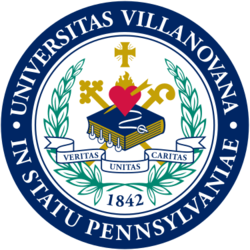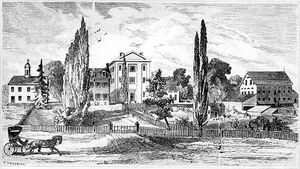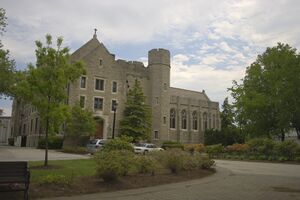Difference between revisions of "Villanova University"
(Added: type, website, other_names, motto.) |
(unstub) |
||
| (2 intermediate revisions by 2 users not shown) | |||
| Line 2: | Line 2: | ||
|wikipedia=https://en.wikipedia.org/wiki/Villanova_University | |wikipedia=https://en.wikipedia.org/wiki/Villanova_University | ||
|constitutes=university | |constitutes=university | ||
| − | |||
|start= | |start= | ||
|headquarters= | |headquarters= | ||
|type=Private | |type=Private | ||
| + | |logo=Villanova University seal.png | ||
|website=http://www.villanova.edu | |website=http://www.villanova.edu | ||
|other_names=Wildcats | |other_names=Wildcats | ||
|motto=Veritas, Unitas, Caritas | |motto=Veritas, Unitas, Caritas | ||
| + | |motto_translation=Latin | ||
| + | |description=75 percent of Villanova undergraduates are Catholic | ||
}} | }} | ||
| + | '''Villanova University''' is a [[private university|private]] [[Catholic higher education|Catholic]] [[research university|research]] university in [[Villanova, Pennsylvania]]. Named after [[Thomas of Villanova|Saint Thomas of Villanova]], the university is the oldest [[Catholic higher education|Catholic university]] in Pennsylvania and the only [[Order of Saint Augustine|Augustinian]] university in the United States.<ref>https://www1.villanova.edu/villanova/unicommunication/nations_augustinian_catholic_university.html</ref> It is [[Carnegie Classification of Institutions of Higher Education|classified]] among "R2: Doctoral Universities – High research activity".<ref>https://carnegieclassifications.iu.edu/lookup/view_institution.php?unit_id=216597 |publisher=Center for Postsecondary Education </ref> According to the [[National Science Foundation]], Villanova spent $20.7 million on research and development in 2018, ranking it 267th in the nation.<ref>Table 20. Higher education R&D expenditures, ranked by FY 2018 R&D expenditures: FYs 2009–18 https://ncsesdata.nsf.gov/herd/2018/html/herd18-dt-tab020.html </ref> | ||
| + | |||
| + | Founded in 1842 by the [[Order of Saint Augustine]], the university traces its roots to [[St. Augustine Church, Philadelphia|old Saint Augustine's Church]], Philadelphia, which the Augustinian friars of the Province of Saint Thomas of Villanova founded in 1796, and to its parish school, Saint Augustine's Academy, which was established in 1811. The school's identity remains deeply rooted in its Augustinian Catholic foundation—the majority of students are Catholic,<ref>"As of fall 2009, 75 percent of Villanova undergraduates are Catholic" http://www.villanovan.com/university-preserves-catholic-tradition/article_c490a495-9593-5ea9-ae8a-c79aa36da0b7.html</ref> the administration is led by priests, there is a cross on every building,<ref>“On every building on campus, there’s a cross,” Fr. Peter Donohue, university president, told the Inquirer. https://www.catholicnewsagency.com/news/catholic-colleges-new-bridge-too-catholic-neighbors-complain-90660</ref> and all students are required to take the Augustine and Culture Seminar (ACS) course their freshman year.<ref>https://www1.villanova.edu/villanova/artsci/acsp.html</ref> | ||
| + | |||
| + | ==History== | ||
| + | [[File:Oldnova.jpg|thumb|Villanova College in 1849]] | ||
| + | |||
| + | In October 1841, two Irish [[Order of Saint Augustine|Augustinian friars]] from [[Saint Augustine]]'s Church in Philadelphia purchased the {{convert|200|acre|adj=on}} "Belle Air" estate in Radnor Township with the intention of starting a school. The school, which was called the "Augustinian College of Villanova", opened in 1842. However, the [[Philadelphia Nativist Riots]] of 1844 that burned Saint Augustine's Church in Philadelphia caused financial difficulties for the Augustinians, and the college was closed in February 1845. The college reopened in 1846 and graduated its first class in 1847. In March 1848, the governor of Pennsylvania incorporated the school and gave it the power to grant degrees. In 1859, the first master's degree was conferred on a student.<ref>Address by Dean of the Graduate School Gerald Long to incoming graduate students. August 24, 2008.</ref> In 1857, the school closed again as the demand for priests in Philadelphia prevented adequate staffing, and the crisis of the [[Panic of 1857]] strained the school financially. The school remained closed throughout the Civil War and reopened in September 1865; since then it has operated continuously.<ref>https://web.archive.org/web/20070708233509/http://www.heritage.villanova.edu/history.html</ref> Its [[Malvern Preparatory School|prep department]] later moved to [[Malvern, Pennsylvania|Malvern]], a town along the [[Philadelphia Main Line|Main Line]], and is still run by the order. | ||
| + | |||
| + | [[File:Corr Hall.jpg|thumb|left|Corr Hall from The Grotto]] | ||
| + | |||
| + | The School of Technology was established in 1905. In 1915, a two-year pre-medical program was established to help students meet medical schools' new requirements. This led to a four-year pre-medical program, the B.S. in biology, and the founding of the sciences division in 1926. | ||
| + | |||
| + | Villanova was all-male until 1918, when the college began evening classes to educate [[nun]]s to teach in [[parochial school]]s. In 1938, a laywoman received a Villanova degree for the first time. It was not until the nursing school opened in 1953 that women permanently began attending Villanova full-time. In 1958, the College of Engineering admitted its first female student; other colleges admitted women only as commuters. Villanova University became fully coeducational in 1968. | ||
| + | |||
| + | During World War II, Villanova was one of 131 colleges and universities nationally that took part in the [[V-12 Navy College Training Program]] which offered students a path to a Navy commission.<ref>https://web.archive.org/web/20120406132413/http://heritage.villanova.edu/vu/heritage/allthings/2002SPh.htm </ref> It has since graduated 25 US Naval Admirals and Marine Corps Generals, which is more than any other college or university with the exception of the Naval Academy in Annapolis.<ref>https://www1.villanova.edu/villanova/artsci/nrotc.html</ref> | ||
| + | |||
| + | After World War II, Villanova expanded, returning [[veterans]] swelling enrollments and the faculty growing fourfold. Additional facilities were built, and in 1953, the College of [[Nursing]] and the School of Law were established. Villanova achieved university status on November 18, 1953. Between 1954 and 1963, 10 new buildings were built or bought on land adjacent to the campus, including Bartley, Mendel, and Dougherty Halls.<ref>https://web.archive.org/web/20080121084409/http://media.www.villanovan.com/media/storage/paper581/news/2006/09/07/Features/The-Facts.About.The.History.Of.Villanova-2262405-page3.shtml</ref> | ||
| + | |||
| + | ===NROTC=== | ||
| + | Villanova [[NROTC]] is part of the Philadelphia NROTC Consortium; consisting of Villanova University and the [[University of Pennsylvania]] (including the cross town agreements with [[Drexel University|Drexel]] and [[Temple University]]). Located in [[John Barry (naval officer)|Commodore John Barry]] Hall, the NROTC has been a part of the University since immediately after World War II. The battalion consists of more than 100 Navy and Marine Corps midshipmen under the advisement of a staff of Navy and Marine Corps officers and senior enlisted members. | ||
| + | |||
| + | Midshipmen in the Villanova NROTC program are required to take specific Navy and Marine Corps classes, wear their service's uniform on Tuesdays and Thursdays, attend daily physical training events, participate in extra-curricular programs that range from sports teams to rifle-shooting, and adhere to the basic premise that "a midshipman does not lie, cheat, or steal". | ||
| + | |||
| + | Since its inception in the summer of 1946, the NROTC unit on campus has produced 25 Admirals and Generals in the United States Navy and Marine Corps.At one point, there had only been two four-star generals in the U.S. Marine Corps, one of them the Commandant of the Marine Corps, and they had both been graduates of Villanova NROTC. In 2004, the commanders of both [[U.S. Atlantic Fleet|U.S. Naval Forces Atlantic]] ([[William J. Fallon|Admiral William J. Fallon]]) and [[U.S. Pacific Fleet|U.S. Naval Forces Pacific]] ([[Walter Doran|Admiral Walter F. Doran]]) were Villanova NROTC graduates.<ref>https://web.archive.org/web/20081023112943/http://www.cffc.navy.mil/history.htm </ref><ref>http://www.cpf.navy.mil/commander/previous/</ref> Admiral Fallon was later assigned as Commander, U.S. Central Command from March 2007 to March 2008. ADM Fallon was the first Navy officer to hold that position.<ref>http://www.sptimes.com/2007/03/17/Tampabay/With_passing_of_flag_.shtml</ref> | ||
| + | |||
| + | ==Notable Alumni== | ||
| + | Villanova has produced several military and governmental officials, including former Pennsylvania Governor [[Ed Rendell]], former New Hampshire Senator [[Kelly Ayotte]] (Villanova Law), and former Connecticut Governor [[John G. Rowland]].<ref>http://www.nga.org/cms/home/governors/past-governors-bios/page_connecticut/col2-content/main-content-list/title_rowland_john.html</ref> Wife to the governor and [[United States federal judge|federal judge]] for the [[United States Court of Appeals for the Third Circuit]], [[Marjorie Rendell]], is also a graduate. Numerous Marine generals and Naval Admirals are products of Villanova's [[NROTC|Naval ROTC]] program, including [[William J. Fallon]], Admiral in the United States Navy and Commander of [[United States Central Command]]; [[George B. Crist]], Marine General and the first Marine to be designated Commander in Chief, Central Command; and [[Anthony Zinni]], retired four-star General in the United States Marine Corps, and [[Joseph Clancy (Secret Service)|Joe Clancy]], former [[Director of the United States Secret Service]]. | ||
| + | |||
| + | In business, alumni include [[Robert J. Darretta, Jr.]] – chief financial officer and vice chairman of [[Johnson & Johnson]], [[John Drosdick]] – former CEO of [[Sunoco]], and [[Thomas G. Labrecque]] – former chairman and CEO of [[Chase Manhattan Bank]]. | ||
| + | |||
| + | Other notable alumni include [[John Joseph O'Connor]], Cardinal Archbishop of the [[Archdiocese of New York]], [[John L. Hennessy]], former president of [[Stanford University]], [[Deirdre Imus]], head of the Deirdre Imus Environmental Center for Pediatric Oncology (and wife to radio host [[Don Imus]]), and [[Sean M. Carroll|Sean Carroll]], a [[cosmologist]] and science popularizer. | ||
| + | |||
| + | |||
| + | |||
| + | |||
| + | |||
| + | |||
{{SMWDocs}} | {{SMWDocs}} | ||
==References== | ==References== | ||
{{reflist}} | {{reflist}} | ||
| − | |||
Latest revision as of 03:26, 5 February 2021
(University) | |
|---|---|
 | |
| Motto | Veritas, Unitas, Caritas (Latin) |
| Type | Private |
| Other name | Wildcats |
| 75 percent of Villanova undergraduates are Catholic | |
Villanova University is a private Catholic research university in Villanova, Pennsylvania. Named after Saint Thomas of Villanova, the university is the oldest Catholic university in Pennsylvania and the only Augustinian university in the United States.[1] It is classified among "R2: Doctoral Universities – High research activity".[2] According to the National Science Foundation, Villanova spent $20.7 million on research and development in 2018, ranking it 267th in the nation.[3]
Founded in 1842 by the Order of Saint Augustine, the university traces its roots to old Saint Augustine's Church, Philadelphia, which the Augustinian friars of the Province of Saint Thomas of Villanova founded in 1796, and to its parish school, Saint Augustine's Academy, which was established in 1811. The school's identity remains deeply rooted in its Augustinian Catholic foundation—the majority of students are Catholic,[4] the administration is led by priests, there is a cross on every building,[5] and all students are required to take the Augustine and Culture Seminar (ACS) course their freshman year.[6]
History
In October 1841, two Irish Augustinian friars from Saint Augustine's Church in Philadelphia purchased the 200-acre (81 ha) "Belle Air" estate in Radnor Township with the intention of starting a school. The school, which was called the "Augustinian College of Villanova", opened in 1842. However, the Philadelphia Nativist Riots of 1844 that burned Saint Augustine's Church in Philadelphia caused financial difficulties for the Augustinians, and the college was closed in February 1845. The college reopened in 1846 and graduated its first class in 1847. In March 1848, the governor of Pennsylvania incorporated the school and gave it the power to grant degrees. In 1859, the first master's degree was conferred on a student.[7] In 1857, the school closed again as the demand for priests in Philadelphia prevented adequate staffing, and the crisis of the Panic of 1857 strained the school financially. The school remained closed throughout the Civil War and reopened in September 1865; since then it has operated continuously.[8] Its prep department later moved to Malvern, a town along the Main Line, and is still run by the order.
The School of Technology was established in 1905. In 1915, a two-year pre-medical program was established to help students meet medical schools' new requirements. This led to a four-year pre-medical program, the B.S. in biology, and the founding of the sciences division in 1926.
Villanova was all-male until 1918, when the college began evening classes to educate nuns to teach in parochial schools. In 1938, a laywoman received a Villanova degree for the first time. It was not until the nursing school opened in 1953 that women permanently began attending Villanova full-time. In 1958, the College of Engineering admitted its first female student; other colleges admitted women only as commuters. Villanova University became fully coeducational in 1968.
During World War II, Villanova was one of 131 colleges and universities nationally that took part in the V-12 Navy College Training Program which offered students a path to a Navy commission.[9] It has since graduated 25 US Naval Admirals and Marine Corps Generals, which is more than any other college or university with the exception of the Naval Academy in Annapolis.[10]
After World War II, Villanova expanded, returning veterans swelling enrollments and the faculty growing fourfold. Additional facilities were built, and in 1953, the College of Nursing and the School of Law were established. Villanova achieved university status on November 18, 1953. Between 1954 and 1963, 10 new buildings were built or bought on land adjacent to the campus, including Bartley, Mendel, and Dougherty Halls.[11]
NROTC
Villanova NROTC is part of the Philadelphia NROTC Consortium; consisting of Villanova University and the University of Pennsylvania (including the cross town agreements with Drexel and Temple University). Located in Commodore John Barry Hall, the NROTC has been a part of the University since immediately after World War II. The battalion consists of more than 100 Navy and Marine Corps midshipmen under the advisement of a staff of Navy and Marine Corps officers and senior enlisted members.
Midshipmen in the Villanova NROTC program are required to take specific Navy and Marine Corps classes, wear their service's uniform on Tuesdays and Thursdays, attend daily physical training events, participate in extra-curricular programs that range from sports teams to rifle-shooting, and adhere to the basic premise that "a midshipman does not lie, cheat, or steal".
Since its inception in the summer of 1946, the NROTC unit on campus has produced 25 Admirals and Generals in the United States Navy and Marine Corps.At one point, there had only been two four-star generals in the U.S. Marine Corps, one of them the Commandant of the Marine Corps, and they had both been graduates of Villanova NROTC. In 2004, the commanders of both U.S. Naval Forces Atlantic (Admiral William J. Fallon) and U.S. Naval Forces Pacific (Admiral Walter F. Doran) were Villanova NROTC graduates.[12][13] Admiral Fallon was later assigned as Commander, U.S. Central Command from March 2007 to March 2008. ADM Fallon was the first Navy officer to hold that position.[14]
Notable Alumni
Villanova has produced several military and governmental officials, including former Pennsylvania Governor Ed Rendell, former New Hampshire Senator Kelly Ayotte (Villanova Law), and former Connecticut Governor John G. Rowland.[15] Wife to the governor and federal judge for the United States Court of Appeals for the Third Circuit, Marjorie Rendell, is also a graduate. Numerous Marine generals and Naval Admirals are products of Villanova's Naval ROTC program, including William J. Fallon, Admiral in the United States Navy and Commander of United States Central Command; George B. Crist, Marine General and the first Marine to be designated Commander in Chief, Central Command; and Anthony Zinni, retired four-star General in the United States Marine Corps, and Joe Clancy, former Director of the United States Secret Service.
In business, alumni include Robert J. Darretta, Jr. – chief financial officer and vice chairman of Johnson & Johnson, John Drosdick – former CEO of Sunoco, and Thomas G. Labrecque – former chairman and CEO of Chase Manhattan Bank.
Other notable alumni include John Joseph O'Connor, Cardinal Archbishop of the Archdiocese of New York, John L. Hennessy, former president of Stanford University, Deirdre Imus, head of the Deirdre Imus Environmental Center for Pediatric Oncology (and wife to radio host Don Imus), and Sean Carroll, a cosmologist and science popularizer.
Alumni on Wikispooks
| Person | Born | Died | Nationality | Summary | Description |
|---|---|---|---|---|---|
| Adrienne Arsht | 4 February 1942 | US | Banker Lawyer Deep state actor | Executive Vice Chair of Atlantic Council | |
| Kelly Ayotte | 27 June 1968 | US | Politician Lawyer | US lawyer and politician, Attorney General of New Hampshire 2004-2009 | |
| Joseph Clancy | 1955 | Spook | Director of the United States Secret Service 2014-2017 | ||
| John LaFalce | 6 October 1939 | US | Politician | US politician who crafted legislation that became the Financial Services Modernization Act of 1999, often cited as a cause of the 2007 Global Financial Crisis. Bilderberg 2002. | |
| Ali Soufan | 8 July 1971 | US Lebanon | Spook | Arab-speaking FBI agent who was involved in a number of high-profile anti-terrorism cases | |
| Tony Szamboti | Engineer | ||||
| Richard Trumka | 24 July 1949 | 5 August 2021 | US | Trade unionist | US union leader who died a week after supporting mandatory vaccination as president of the AFL-CIO. |
References
- ↑ https://www1.villanova.edu/villanova/unicommunication/nations_augustinian_catholic_university.html
- ↑ https://carnegieclassifications.iu.edu/lookup/view_institution.php?unit_id=216597 |publisher=Center for Postsecondary Education
- ↑ Table 20. Higher education R&D expenditures, ranked by FY 2018 R&D expenditures: FYs 2009–18 https://ncsesdata.nsf.gov/herd/2018/html/herd18-dt-tab020.html
- ↑ "As of fall 2009, 75 percent of Villanova undergraduates are Catholic" http://www.villanovan.com/university-preserves-catholic-tradition/article_c490a495-9593-5ea9-ae8a-c79aa36da0b7.html
- ↑ “On every building on campus, there’s a cross,” Fr. Peter Donohue, university president, told the Inquirer. https://www.catholicnewsagency.com/news/catholic-colleges-new-bridge-too-catholic-neighbors-complain-90660
- ↑ https://www1.villanova.edu/villanova/artsci/acsp.html
- ↑ Address by Dean of the Graduate School Gerald Long to incoming graduate students. August 24, 2008.
- ↑ https://web.archive.org/web/20070708233509/http://www.heritage.villanova.edu/history.html
- ↑ https://web.archive.org/web/20120406132413/http://heritage.villanova.edu/vu/heritage/allthings/2002SPh.htm
- ↑ https://www1.villanova.edu/villanova/artsci/nrotc.html
- ↑ https://web.archive.org/web/20080121084409/http://media.www.villanovan.com/media/storage/paper581/news/2006/09/07/Features/The-Facts.About.The.History.Of.Villanova-2262405-page3.shtml
- ↑ https://web.archive.org/web/20081023112943/http://www.cffc.navy.mil/history.htm
- ↑ http://www.cpf.navy.mil/commander/previous/
- ↑ http://www.sptimes.com/2007/03/17/Tampabay/With_passing_of_flag_.shtml
- ↑ http://www.nga.org/cms/home/governors/past-governors-bios/page_connecticut/col2-content/main-content-list/title_rowland_john.html

